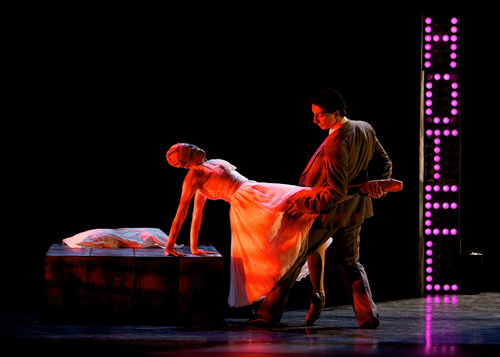 United Kingdom Peter Salem, A Streetcar Named Desire: Scottish Ballet, Edinburgh Festival Theatre, 18.4.2012 (SRT)
United Kingdom Peter Salem, A Streetcar Named Desire: Scottish Ballet, Edinburgh Festival Theatre, 18.4.2012 (SRT)
Blanche DuBois: Eve Mutso
Stella: Sophie Martin
Stanley: Tama Berry
Alan: Victor Zarallo
Direction: Nancy Meckler
Choreography: Annabelle Lopez Ochoa
Music and Sound: Peter Salem

This is the third Scottish Ballet piece I’ve seen in the last 12 months, and it’s the best. In fact, it probably isn’t going too far to say that, as a piece of drama, it’s the most satisfying piece of dance I’ve seen so far from anyone. It was an inspired idea of Ashley Page’s to team up with Nancy Meckler, Artistic Director of Shared Experience, to present a new version of Tennessee Williams’ quintessential American tragedy. Meckler’s work has explored new ways of uniting text-based drama with physical theatre, and she turned out to be a perfect choice for exploring how to reinterpret Streetcar for dance.
Key to this production’s success is the clarity with which they tell the story, and the distinctive element for this realisation is that they make explicit much of Blanche’s back-story. Elements which are merely hinted at in Williams’ play, and sometimes only obliquely, are here made visual. We see Blanche’s youth at her family’s home, Belle Reve, her early marriage and her husband’s dalliance with another man, which causes him to take his own life. It’s a very effective way of presenting what would otherwise have been impossible to suggest in a format without dialogue, and it creates some visual leitmotifs which run throughout the piece, often underlining Blanche’s descent into delusion later in the drama. The simple creativity of the set helps the storytelling too, a quantity of crates being used to evoke a range of locations from the street to the bowling alley through to the claustrophobia of the apartment that frames so much of the action.
Annabelle Lopez Ochoa’s choreography energises the pace of the drama with the way it delineates and deepens our understanding of each character. At the centre is the brittle, fragile figure of Blanche herself, danced with extraordinary energy by Eve Mutso. Her flighty, elegant movements often stand in grim contrast to the horrible situation in which she finds herself, and they serve to underline her retreat into fantasy as the drama progresses. Williams’ original working title for the play was The Moth, an apt illustration for the fragile, faded belle who flirts with the thing that will destroy her, and at various junctures in the piece this image informs Blanche’s movements. She is almost upstaged by the excellent Sophie Martin as Blanche’s sister, Stella. Martin invests the role with incredible vigour, and her duet with Stanley at the end of Act 1 is characterised by extraordinary flights of suppleness and eroticism. Both women jar with the powerful masculinity of Stanley, embodied with commanding forcefulness by Tamar Barry who, rightly, dominates the stage in all of his scenes. He smoulders with suppressed tension while Blanche flits lightly from fantasy to reality. The final rape scene is grim in its austerity, as is Blanche’s final, irreversible descent into delusion.
The original score by Peter Salem works very effectively. It’s sometimes melodic, but more often it’s evocative and places the action squarely in a particular mood. It’s a bit more than a soundtrack, but it has all the virtues of painting with sound that the best film scores have. He also cleverly uses recorded sounds to suggest atmosphere – the nocturnal cicadas, the crash of the bowling pins, the bell of the streetcar – and the use of an Ella Fitzgerald song creates an audio leitmotif that is as powerful in its way as what we see.
It’s not often in my experience that a piece of dance can work as powerfully and evocatively as this, registering all the power of the finest dramas while barely uttering a word. It’s a credit to Scottish Ballet that they have undertaken it and triumphed so singularly, and they deserve to have a hit on their hands. Ashley Page is due to step down as Artistic Director in August of this year, ten years after he took up the post. He is undoubtedly leaving the company in a much better state than that in which he found it.
Simon Thompson